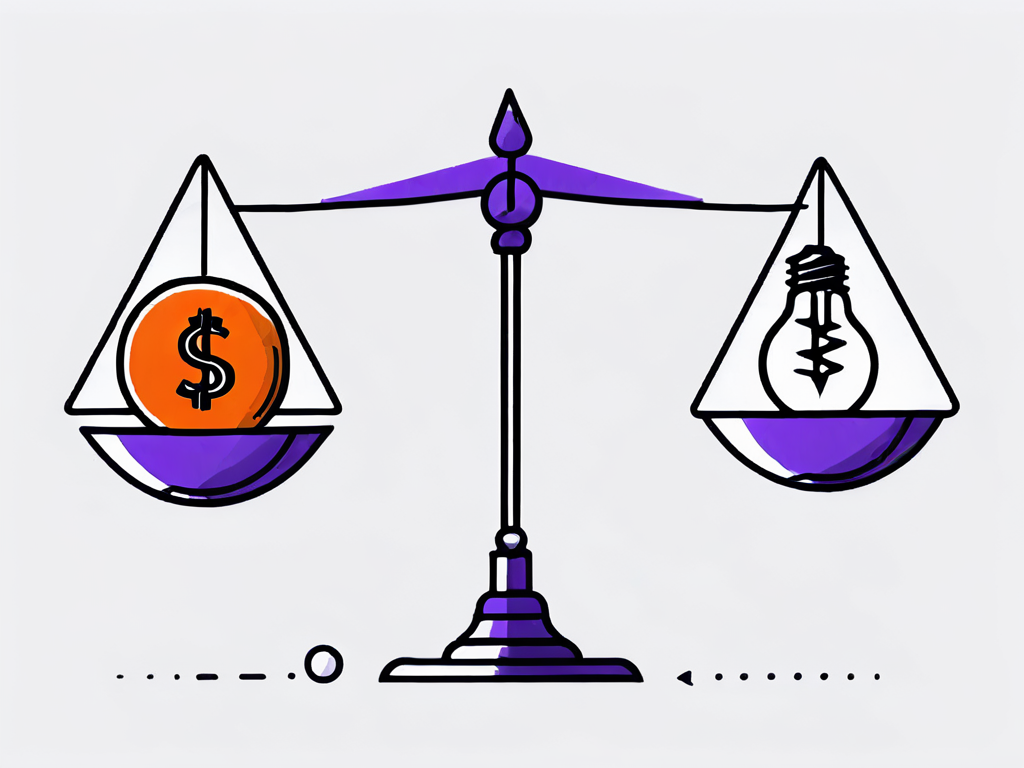Every year, thousands of startups around the world strive to achieve financial stability. But before they can reach profitability, they must first navigate the treacherous sea known as the breakeven point.
Understanding this concept and how to analyze a startup breakeven point is crucial for success. Knowing your breakeven point is the beginning of financial wisdom for startups. Throughout this article, expect to learn:
- How to calculate and analyze startup breakeven point
- How to lower the breakeven point
- Common mistakes to avoid in breakeven analysis
Table of Contents
ToggleA Guide to Analyze Startup Breakeven Point + Easy-to-Use Calculator
In order to calculate your breakeven point, first you’ll need to download the template we prepared below. Worry not, because it’s completely free of charge
CALCULATOR FOR STARTUP BREAKEVEN POINT
Calculating the breakeven point involves several steps that require a thorough understanding of the startup’s cost structure and pricing strategy. Let’s break it down:
Understanding the breakeven point is crucial for any business, as it indicates the level of sales needed to cover all costs and start generating profit. By mastering this calculation, entrepreneurs can make informed decisions about pricing, production levels, and overall business strategy.
Identifying Fixed and Variable Costs
The first step in determining the breakeven point is to separate fixed and variable costs. Fixed costs include:
- Rent
- Salaries
- Utilities
Variable costs encompass:
- Raw materials
- Commissions
- Packaging expenses
Categorizing these costs accurately is crucial for accurate breakeven analysis.
Fixed costs remain constant regardless of production levels, while variable costs fluctuate based on the number of units produced. By understanding and categorizing these costs correctly, businesses can allocate resources effectively and optimize their cost structure.
Determining the Selling Price per Unit
Next, it’s essential to determine the selling price per unit. This price should not only cover the variable costs associated with producing each unit but also contribute towards covering the fixed costs of the business. Setting the right selling price can make or break a startup’s breakeven point.
Setting a competitive yet profitable selling price requires a deep understanding of:
- Market dynamics
- Customer behavior
- Production costs
Businesses must strike a balance between attracting customers with affordable prices and ensuring that each sale contributes to covering both variable and fixed expenses.
Calculating the Breakeven Point
Now comes the moment of truth – calculating the breakeven point itself. This is done by dividing the total fixed costs by the contribution margin per unit. The contribution margin is the difference between the selling price per unit and the variable cost per unit. The resulting figure represents the number of units that need to be sold in order for the startup to break even.
By accurately calculating the breakeven point, businesses can:
- Set realistic sales targets
- Evaluate performance against financial goals
- Make informed decisions about pricing strategies and cost management
This calculation serves as a critical tool for financial planning and business sustainability, guiding entrepreneurs towards profitability and long-term success.
Interpreting the Breakeven Analysis
An accurate breakeven analysis enables startups to determine how their current sales volume compares to the breakeven point. If the sales volume exceeds the breakeven point, the startup is generating profits. Conversely, if sales volume falls below the breakeven point, the startup is incurring losses.
Moreover, breakeven analysis can also help startups set realistic sales targets and assess the feasibility of new projects or ventures. By continuously monitoring and interpreting the breakeven point, businesses can adapt their strategies to optimize profitability and ensure long-term sustainability.
Factors that Influence the Breakeven Point
Several factors can influence a startup’s breakeven point, including:
- Market conditions
- Competition
- Pricing strategy
- Cost structure
Understanding these factors and their impact on the breakeven point allows startups to make strategic adjustments to stay on the path to profitability.
Strategies to Lower the Breakeven Point
Lowering the breakeven point can significantly improve a startup’s financial health. Consider implementing the following strategies:

Reducing Fixed Costs
One way to lower the breakeven point is by reducing fixed costs. This could involve:
- Renegotiating rent agreements
- Finding more cost-efficient suppliers
- Exploring shared workspace options
By trimming unnecessary expenses, startups can decrease their breakeven point and potential losses.
Furthermore, startups can also consider outsourcing certain functions to reduce overhead costs. By leveraging the expertise of external service providers for tasks like accounting, IT support, or marketing, startups can benefit from cost savings without compromising on quality. This strategic move not only lowers the breakeven point but also allows startups to focus on their core competencies.
Increasing the Selling Price
Another strategy is to increase the selling price of the product or service. However, this should be done carefully to avoid alienating customers. Conduct market research to determine the optimal price that balances profitability with customer demand.
In addition to adjusting the selling price, startups can explore bundling products or services to provide value-added offerings to customers. By creating packages that cater to different customer needs and price points, startups can increase their average transaction value and accelerate their journey to profitability.
Boosting Sales Volume
Increasing sales volume is a straightforward approach to lowering the breakeven point. Startups can achieve this by:
- Implementing effective marketing and sales strategies
- Expanding their customer base
- Improving customer satisfaction
Every additional unit sold brings them closer to profitability.
Moreover, startups can consider forming strategic partnerships or collaborations with complementary businesses to tap into new markets and customer segments. By leveraging the strengths and resources of partners, startups can drive mutual growth and expand their sales volume, ultimately reducing their breakeven point and enhancing their financial sustainability.
Pitfalls to Avoid in Breakeven Analysis
While breakeven analysis is a powerful tool, it’s important to tread carefully and avoid common mistakes that can lead to inaccurate results:

Common Mistakes in Breakeven Analysis
Common pitfalls that can distort breakeven analysis include:
- Miscalculating costs
- Ignoring market dynamics
- Assuming constant sales volume
Startups must ensure they have accurate and up-to-date cost data, consider market fluctuations, and account for potential variations in sales volume.
Ensuring Accurate Breakeven Analysis
To ensure accurate breakeven analysis, startups should:
- Regularly review their cost structure
- Update pricing strategies
- Monitor market conditions
By keeping a finger on the pulse of their business, startups can maintain a clear understanding of their breakeven point and make informed decisions accordingly.
It is also crucial for startups to factor in external variables that can impact their breakeven point, such as:
- Changes in regulations
- Shifts in consumer preferences
- Advancements in technology
These external factors can influence costs, pricing strategies, and market demand, all of which play a significant role in determining the breakeven point.
Understanding the Concept of Breakeven Point
Imagine a scenario where a startup’s total expenses exactly match its total revenue. This is the magical moment known as the breakeven point. At this stage, the startup neither makes a profit nor incurs a loss. It’s a delicate equilibrium that provides valuable insights into the viability of a business.
Calculating the breakeven point involves a detailed analysis of a company’s cost structure and revenue streams. It requires a deep dive into fixed costs, variable costs, and selling prices to determine the exact level of sales needed to cover all expenses. This exercise not only helps in understanding the financial health of the business but also guides strategic decision-making.
The Importance of Breakeven Point in Startups
The breakeven point is a critical metric for startups as it helps them assess how their costs, pricing, and sales volume relate to profitability. By knowing the specific point at which they start generating profits, startups can make informed decisions about:
- Pricing strategy
- Cost structure
- Overall business model
Furthermore, the breakeven point serves as a benchmark for evaluating the performance of a startup over time. By comparing actual sales figures to the breakeven point, entrepreneurs can gauge the efficiency of their operations and identify areas for improvement. This ongoing analysis is crucial for sustaining long-term growth and success in a competitive market.
Take Charge: Secure Your Startup’s Financial Future
Understanding and accurately analyzing your startup’s breakeven point is essential for achieving financial stability and long-term success. By mastering this critical metric, entrepreneurs can make informed decisions about pricing, cost management, and sales strategies, ensuring that their business is on a clear path to profitability.
Regularly reviewing and adjusting your breakeven analysis allows you to adapt to market changes, optimize resources, and strategically plan for growth, ultimately securing your startup’s financial future with Fulfyld.






